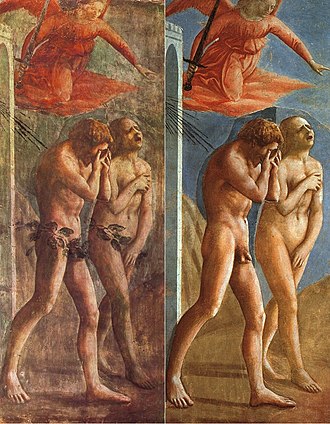Differences from Genesis
The main points in this painting that deviate from the account as it appears in Genesis:
- Adam and Eve are shown in the nude. Although this increases the drama of the scene, it differs from Genesis 3:21 (KJV) which states, "Unto Adam also and to his wife did the LORD God make coats of skins, and clothed them."
- Only one Cherub angel is present. Genesis 3:24 states, "So he drove out the man; and he placed at the east of the garden of Eden Cherubims, [...]" (-im being the original Hebrew plural ending of Cherub, doubled with an English plural in this version).
- The arch depicted at the garden entrance does not appear in the Biblical account.
However, since artists often followed the studio tradition, painting from previous versions of a scene--and so learning from and absorbing other artists' expressive inventions into their own work--any responsible iconographic study would founder in the shallows of literal expectation if the painting were only judged by its adherence to these details and therefore seen to be successful only if it functioned as a simple illustration for the scene.
Masaccio's evocation of Eve's howling, deeply felt pain in particular explores the meaning of the expulsion on a previously unexamined, more personal level.
In 2nd Temple Jewish texts, however, Adam is described as glorious (Sirach 49, &c.), and in both some Rabbinic and Christian Patristic sources, there is a long tradition of reading the Hebrew word for "skin" as "light" (there is only one slight difference in the vowels between the two words), and taking the Genesis 3:21 words about God clothing the pair in the Pluperfect sense, such as Sebastian Brock has shown is done in the Syriac tradition. In Rabbinic sources there are several times when Adam is compared and contrasted with Moses, particularly in terms of Moses' luminosity after ascending the mountain, and at least one text where Moses claims that his glory is greater than Adam's, because he did not lose his glory (Deuteronomy Rabbah 11:3); Genesis Rabbah 20:12 notes that Rabbi Meir had a scroll that had "light" instead of skin. The same tradition is found in Ephrem the Syrian, who, in his Hymns on Paradise 6, talks about Christ clothing the faithful in the robe that Adam lost with the transgression. The Canon of St. Andrew of Crete has the cantor liken himself to Adam, and say "I have found myself stripped naked of God". Bede, in his commentary On Genesis, has similar comments: "having lost the glory of innocence by their transgression, they claimed for themselves the garment of an excuse". The "stripped of divinity/glory/innocence/honor motif is thus found in the Latin, Greek, and Syriac traditions of the Church. It seems quite possible that these artists were working within this very old tradition that stretches across traditions.
This page is based on this
Wikipedia article Text is available under the
CC BY-SA 4.0 license; additional terms may apply.
Images, videos and audio are available under their respective licenses.


